Sins of a Solar Empire 2 is reaching for the stars
Nearly 15 years after the original launched, Ironclad and Stardock's 4X RTS is back.
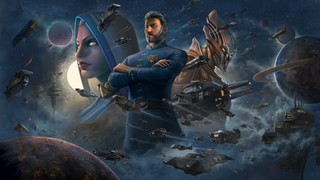
For a lover of 4Xs who never quite got over the decline of real-time strategy, Sins of a Solar Empire was a panacea. It took most of what I adored about both strategy models and smooshed them together in an epic clash in space. It was a revelation that I expected to inspire imitators, but nearly 15 years on nobody else has attempted to replicate this extremely successful experiment. Thankfully, that's about to change. Sins of a Solar Empire 2 is coming.
Developer Ironclad Games has been thinking about this sequel for a long time. The last piece of Sins DLC came out in 2018, a decade after the base game launched, and while Ironclad didn't immediately start work on Sins 2 after that—development only began in earnest just over a year ago—discussions were already happening. The Minor Factions DLC wasn't just a last hurrah for Sins: it was a hint at the future of the series.
"We were always thinking, let's do a testbed on this," says Ironclad co-owner Blair Fraser. "Since Sins 2 is going to come out, what would this look like?" The original Sins was "much, much more combat focused", but through the expansions the team was able to experiment more with diplomacy and NPC factions. And for Sins 2, Ironclad has "gone to town" on that aspect of its cosmic conflict.
So while Sins always had the empire management that you'd expect from a 4X, it looks like it'll be a lot more evident this time, with more interactions that go beyond, as Fraser puts it, "just blowing up the enemy" in real-time space brawls. "Sins 2 is really the merging of what else we can do between tactical and high-level empire management that other people have requested and we never got around to doing." It's a product of 15 years of feedback and feature wish lists.
But the original's greater focus on that final X, exterminate, is what made it stand out from both its contemporaries and, later, Stellaris, which went down the real-time route but didn't contain Sins' more granular focus on ship combat. That legacy remains important.
Turret up
This is clear from one of the big new features that Ironclad is currently touting: "You've got turrets that actually move and fire and acquire targets in real-time," Fraser explains. "If you remember Sins 1 and the expansions, given the technology at the time, and the number of units we were using, we were only able to do four banks. All weapons in a bank had the same firing solutions and acquired the same targets. It was just a computational necessity."
Multi-threading was still new, and the limitations of 2008's technology forced Ironclad to keep things straightforward. But 15 years of advances have allowed the team to make individual turrets and fully-simulated missiles—things Fraser and his fellow designers wish they could have done before—a reality. "Not only does it look awesome, but from a tactical point of view, it introduces a whole bunch of new changes to the combat mechanics."
The biggest gaming news, reviews and hardware deals
Keep up to date with the most important stories and the best deals, as picked by the PC Gamer team.
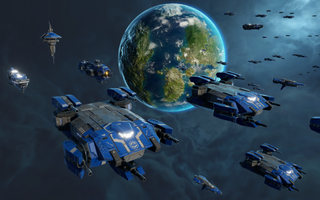
So now you've got point defence turrets "spinning and trying to track these things and shoot them down", and beefy capital ships with heavy armour blocking the missile fire and protecting the glass cannons in the back, which act more like 20th century artillery. The larger ships are like squads or small armies, with greater capabilities and flexibility, though you won't need to manually control each turret. And you'll still be able to eschew micromanagement by setting ships to autocast their abilities.
For fans of micro, however, there's more to play with and more to consider. Smart positioning of your ships, for instance, is a lot more crucial because ships and celestial objects now create line-of-sight wrinkles.
Ironclad has also changed the system of counters and arbitrary bonuses, so instead of ships getting automatic bonuses against ships of a specific type, their performance is now determined by the properties of the offensive and defensive systems. To put it simply: "If you have heavy armour, anything that has armour penetration will do better against it than something that doesn't."
Detour
The low-level tactical combat isn't the only thing that's going more granular and simulated. The galaxy itself has been given the same kind of love. Planets now orbit their stars, and moons now orbit their planets. "What this creates is a dynamic galaxy you have to plan around," Fraser says. The inspiration for this comes from an unlikely source: Buck Rogers – Battle for the 25th Century, an '80s board game based on the classic sci-fi romp. It wasn't a commercial success, but it certainly had an impact on Fraser, who still has the box sitting on his shelf.
Where things get really interesting is how the motion of these worlds can screw you, or your foes, over.
You won't need to squeeze into tight jumpsuits or show off your chest hair, but you will need to pay attention to celestial mechanics. As before, everything is linked up in a network of phase lanes, which determine where ships can travel to directly. But since all of these planets and moons now move, your plans will have to adapt. When a planet is closer to one of your occupied worlds, it might be a good time to launch an invasion or shore up your defences, and when they're further away you might want to focus on other things, like your economy or research. This alone feels incredibly novel, but where things get really interesting is how the motion of these worlds can screw you, or your foes, over.
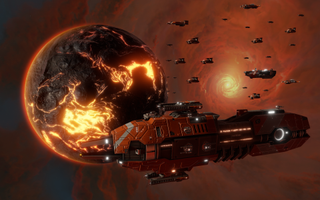
Maybe there's a world you'd really like to snatch up, but it's heavily defended. In that case, you might be better off drawing the enemy fleet away by targeting a less appealing world. And as they are travelling to defend this world, you then grab your fleet and send them to your real target, but because you've been very clever and timed it just right, the enemy fleet can't follow you because the phase lane has shifted and there's no longer a direct route. This happens because planets move at different speeds depending on their proximity to the star, potentially turning them into an obstacle that temporarily severs connections between other worlds.
This sounds complicated, especially in a real-time game, but the UI lends a hand. "Every so often you should hold down the tactical view," Fraser recommends. "And you can see the projections of how the planets are moving. Currently, it's set to 10 minute intervals, so you can see where it's going to be 10 minutes from now, but we may change that and give players the option to set how far they want to project." Planets are also colour-coded so you can tell if they're moving prograde or retrograde, as not every planet moves in the same direction.
These celestial mechanics also inform the rhythm of the conflict and how you'll build your empires. "In a typical game, we've tuned it so that players will start more on the outskirts," Fraser explains. "And because those clusters of planets move a lot slower, they tend to move in a much more cohesive cluster. So the core of your empire, the guts of it, tends to be together for most of the game. At some point in the multi-hour state, they will break apart, but by that point, presumably, if you're winning, you've expanded your empire and you've got a separate frontline anyway. But by design, and based on just a little bit of astronomy, the stuff closer to the star is much less stable. And that's where we'll tend to put the more valuable things. So you get these really interesting contests over these valuable resources and planets."
Objects closer to the star will still take around 30-45 minutes to do a full orbit, but that's also dependent on settings. Like the original Sins, you'll be able to make plenty of tweaks to the sequel, turning things off and on until you create a stellar battlefield that's just right.
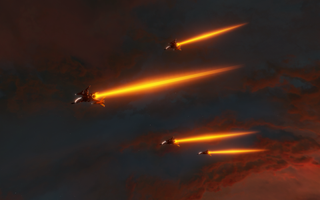
Two topics have generated the most debate within Ironclad. The first is 3D movement. Having more than a 2D plane to work with is a seductive prospect, but this isn't Homeworld, with its exclusive focus on ships; Sins gives you an empire to manage, and heaping yet more complexity on top of what's already a pretty dense game is a risk. Like its predecessor, then, Sins 2 has stuck with 2D movement.
Sins of a Sandbox Empire
The other major subject of debate was the possibility of a campaign or discrete narrative elements like you'd see in Stellaris or Endless Space 2. Ultimately the pure sandbox approach won out—it's what Ironclad knows and what it's already seen success with. "That's not to say we're not very interested in the story of Sins of a Solar Empire," Fraser adds. "There's a very detailed story. It's infused in every ship's ability, all the research subjects, the look and feel of every element, every voice line that every character in the game speaks—the whole thing emits the story."
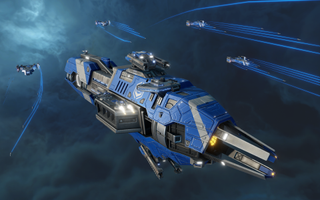
Ironclad is also sticking with the setting of the original Sins, with the TEC, Advent and Vasari continuing their squabble. Sins 2 is a retelling of the conflict, but sped up. You'll start with the original factions, who then splinter into the loyalists and rebels, and then as you expand you'll encounter features that were present in the Entrenchment expansion, and then the Diplomacy expansion, until you hit the brand new stuff unique to Sins 2.
Each faction is distinct, from their metal harvesting rate to the fundamental systems that define them. The TEC, for instance, is the only one that can profit from trade lanes. It's their specialty, as the Trader Emergency Coalition, and the game takes place in TEC space. The trade system, according to Fraser, has also been given an upgrade, with greater sophistication and "more decision making". There was asymmetry in the original Sins, of course, but, he adds, "given the scale of the game, we've leaned into it more".
The more notable differences between factions and the complications of a galaxy that's always in motion should be a boon for multiplayer, as well, which, along with modding, was one of the main reasons Sins enjoyed such longevity. It was a great singleplayer game, and that's how I mostly played it, but it really came to life with PvP. And thanks to strides in tech, the Iron Engine 3 should hopefully be more capable of creating a smooth multiplayer conflict in Sins 2, letting you, for instance, rejoin multiplayer matches without any faffing around. You'll also be able to transfer control of your faction to another player if you don't have time to finish the war.
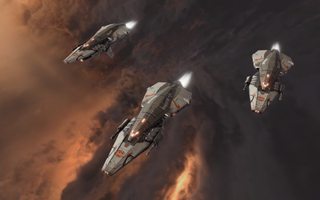
After so many years I'm very keen to start conquering space again. Ironclad and publisher Stardock haven't given away the release date yet, but we'll be able to get our hands on it before the full launch, whenever that might be.
"It'll be a true early access," says Fraser. "But it's very targeted this time, as well. The initial one will probably be just the core game loop. It won't have the guts, all the extra content and all the extra mechanics. It's just: are players able to run this? Can they complete the game? Build a few basic ships, take over planets and wipe out their enemies. It'll be just that core nugget."
There's no date for early access yet, but we will have more Sins of a Solar Empire 2 details to share in the near future. In the meantime, consider grabbing a physics textbook and brushing up on astronomy.

Fraser is the UK online editor and has actually met The Internet in person. With over a decade of experience, he's been around the block a few times, serving as a freelancer, news editor and prolific reviewer. Strategy games have been a 30-year-long obsession, from tiny RTSs to sprawling political sims, and he never turns down the chance to rave about Total War or Crusader Kings. He's also been known to set up shop in the latest MMO and likes to wind down with an endlessly deep, systemic RPG. These days, when he's not editing, he can usually be found writing features that are 1,000 words too long or talking about his dog.

If you love big trucks, establishing trade routes, and the phrase 'post-apocalyptic survival business simulator' then I've got just the strategy RPG for you

Blizzard veteran David Kim's strategy comeback with Battle Aces is 'very personal:' 'I just can't accept... the end-all peak of RTS is StarCraft 2 and nothing can ever be better'
Most Popular

